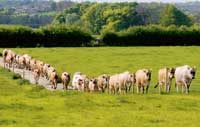Getting the most from tracks

Farmers who invest in good-quality tracks will see big pay back in terms of reduced lameness and better pasture use, according to DairyCo extension officer Jo Speed.
“A good cow track should encourage rapid and comfortable cow flow, minimise lameness and keep cows clean,” she says.
“You can actually see cows speed up on a good track. Investment in quality materials pays off by minimising claw damage and therefore lameness, and a well-made track can extend the grazing season by improving access to pasture and minimising damage as a result of poaching.”
Whether putting in a new track infrastructure, or reviewing current set-ups, it is important to look at the layout of the farm itself, accessibility of water and future cropping plans first.
“It is hard to give an idea of cost for building cow tracks – the price of materials varies widely. Costs can be quite low with a locally sourced stone or rubble, so it is worth asking in your area.”
Materials
Quarry stone or shale would be ideal for the base drainage layer, and it is best to hire in a vibrating roller to compact this layer to increase durability and lifespan. “Tracks sink, so build them up well first.”
The worst culprits for sole damage are road planings and road grit, they get dragged onto the concrete and with muddy feet they can cause a lot of damage.
“Remember when you’re planning to use waste building rubble you will need either an exemption or a permit from the Environment Agency, so check this out beforehand.”
So, what is the ideal cow track? Mrs Speed asks. Width and length alter costs considerably and, as with designing footbaths, you can reduce costs by altering the width. The recommendation is 5m of track width, of which 4m is surfaced to provide good cow flow for 200 cows. Each additional 100 cows require an extra metre width to maintain cow flow.
Drainage
Make the base layer for drainage using stone or rubble, this should be built straight onto the top soil with a raised crown about two feet above ground for drainage. “When it comes to constructing cow tracks drainage is key,” says Mrs Speed. “Get it right and your track should have a long and useful life, get it wrong and you could be facing track failure in the first few years.
Creating a camber and ditches either side of the track will ensure water drains away quickly and effectively. “Water must not be allowed to run down tracks as it turns them into a kind of riverbed and will erode and destroy them in no time. Using a camber of 3-6% with a maximum of 10% supports free draining and gets rid of water.
“Drains should be outside the fence when possible to prevent cows walking on them and damaging them. It is also best to avoid tracks in heavy shade by keeping them on the south facing side of a hedge where you can, as this allows them to dry faster.”
It is also important to know where the water is draining to as there could be environmental issues. When a track is to run within 1m of a waterway then specialist advice should be sought from the Environment Agency.
“There must be either a cross fall of 150mm on narrow tracks (less than four metres) or a camber of 150mm on wider tracks.
“When a track is laid across a dip in the field, allow water to escape from the topside by laying pipes under the track.
“Good maintenance across the whole track is also crucial to its longevity and effectiveness. One 10m section of the track can cause 90% of the problems. Remember to budget in an annual cost for repairs, whatever material you are using for track construction.”
Finally, Mrs Speed stresses that cows should be allowed to walk at their own pace at all times, with their heads down, so they can see where they are putting their feet. “Cows that are driven have their heads up due to the congestion and cannot see where they are putting their feet, and are therefore more likely to suffer from trauma and damage.”
